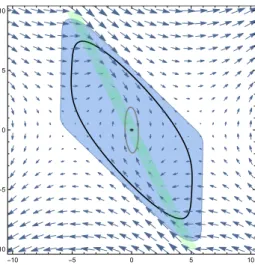HAL Id: hal-02008057
https://hal.archives-ouvertes.fr/hal-02008057
Submitted on 5 Feb 2019HAL is a multi-disciplinary open access
archive for the deposit and dissemination of sci-entific research documents, whether they are pub-lished or not. The documents may come from teaching and research institutions in France or abroad, or from public or private research centers.
L’archive ouverte pluridisciplinaire HAL, est destinée au dépôt et à la diffusion de documents scientifiques de niveau recherche, publiés ou non, émanant des établissements d’enseignement et de recherche français ou étrangers, des laboratoires publics ou privés.
Estimating the robust domain of attraction for
non-smooth systems using an interval Lyapunov
equation
Alexandre Goldsztejn, Gilles Chabert
To cite this version:
Alexandre Goldsztejn, Gilles Chabert. Estimating the robust domain of attraction for non-smooth systems using an interval Lyapunov equation. The 18th International Symposium on Scientific Com-puting, Computer Arithmetic, and Verified Numerical Computations, Sep 2018, Tokyo, Japan. �hal-02008057�
Estimating the robust domain of attraction
for non-smooth systems using an interval
Lyapunov equation
Alexandre Goldsztejn
1,3and Gilles Chabert
21CNRS, LS2N, Ecole Centrale de Nantes, France
2LS2N, Institut des Mines T´el´ecom Atlantique, France
3alexandre.goldsztejn@ls2n.fr
Keywords: Nonlinear non-smooth systems; exponentially stable fixed point; domain of attraction; Lyapunov function; interval analysis.
Contribution
A symmetric positive definite (SPD) matrix P solution to the Lyapunov
equation P A + ATP = Q, with Q an arbitrary symmetric negative definite
(SND) matrix, gives rise to a quadratic Lyapunov function v(x) = xTP x,
whose existence proves that the origin is an exponentially globally stable fixed point of the linear system ˙x = Ax. Solving the Lyapunov equation for the linearization of a nonlinear system can also prove the exponential stability of its fixed points. However, in this case the stability is local and the Lyapunov equation provides no information about the region of attraction.
We present an interval version of the Lyapunov equation, which allows in-vestigating a given Lyapunov candidate function for nonlinear systems inside an explicitly given neighborhood, leading to rigorous estimates of the domain of attraction (EDA) of exponentially stable fixed points. These results are developed in the context of uncertain systems that can be non-smooth, e.g., systems with saturations. In a second step, this EDA is used to define a nonlinear optimization problem whose solution gives rise to the largest EDA (LEDA) that can be inferred using the given Lyapunov function.
A comparison with the state of the art for computing EDA based on Lyapunov functions will be presented. In particular, the proposed process is shown to outperform the approach based on sum-of-squares [1] implemented in smrsoft [2].
Example
We consider the following linear system with saturated input, investigated
in [3]: ˙x1 = x2 and ˙x2 = x1 + 5 max{−1, min{1, −2x1 − x2}}.
-10 -5 0 5 10 -10 -5 0 5 10
Figure 1: The vector field of the saturated linear system. In green, the non-saturated area. The following EDA are displayed: In blue the one from [3], which is the convex hull of two ellipsoids; the gray ellipsoid (resp. black curve) is the boundary of the LEDA computed with the quadratic (resp. degree 4) Lyapunov functions.
Lyapunov equation, we select the Lyapunov candidate function v2(u) =
1.28x21+0.11x1x2+0.11x22. We also consider the degree 4 Lyapunov candidate
function v4(x) = v2(x) + 151(x1+ x2)4, aiming at a larger EDA.
The results obtained are summarized in Figure 1: The LEDA obtained using the quadratic Lyapunov function is computed in 0.05s (the gray el-lipsoid). It is smaller than the one obtained with the degree 4 Lyapunov function, which is computed in 0.2s (the black curve). The latter is smaller, but still competitive with the one computed in [3] (the blue area) using a technic dedicated to linear systems with saturations.
References
[1] Graziano Chesi. Domain of Attraction: Analysis and Control via SOS Programming, volume 415 of Lecture Notes in Control and Information Sciences. Springer, 2011.
[2] Graziano Chesi. SMRSOFT: a matlab toolbox for optimization over
polynomials and dynamical systems study via sos programming. http: //www.eee.hku.hk/~chesi, 2011.
[3] Tingshu Hu, Rafal Goebel, Andrew R. Teel, and Zongli Lin. Conjugate Lyapunov functions for saturated linear systems. Automatica, 41(11):1949 – 1956, 2005.
